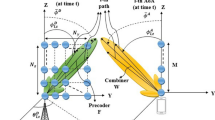Abstract
In order to adapt double codebook beamforming technique in massive MIMO system, double codebook estimation algorithms based on the extended double codebook are proposed in this paper, such as one-dimensional (1D) estimation inherited MIMO, independent two-dimensional (2D) estimation and ESPRIT-like estimation. 1D estimation traverses the candidates based on the cross combination of two directions. Independent 2D estimation traverses the candidates based on two directions separately. ESPRIT-like estimation is based on rotational invariance principle of antenna array, which imposes significantly lower computational complexity than the former two algorithms. Advanced, its complexity does not increase with the number of candidates. Finally, the complexity and system performance with three algorithms are compared and analyzed. The results show that 1D estimation gains the best performance, but it is too complex and difficult for practical implementation. ESPRIT-like estimation is more practical due to its reduced complexity and comparable performance with the independent 2D estimation algorithm, especially with small number of candidates.




Similar content being viewed by others
References
Humadi, K. M., Sulyman, A. I., & Alsanie, A. (2014). Spatial modulation concept for massive multiuser MIMO systems. International Journal of Antennas and Propagation, 2014(1), 1–9.
Larsson, E. G., Edfors, O., Tufvesson, F., et al. (2014). Massive MIMO for next generation wireless systems. IEEE Communications Magazine, 52(2), 186–195.
Zheng, K., Ou, S., & Yin, X. (2014). Massive MIMO channel models: A survey. International Journal of Antennas and Propagation, 2014(11), 1–10.
Jungnickel, V., Manolakis, K., Zirwas, W., et al. (2014). The role of small cells, coordinated multipoint, and massive MIMO in 5G. IEEE Communications Magazine, 52(5), 44–51.
Zhao, L., Zheng, K., Long, H., et al. (2014). Performance analysis for downlink massive multiple-input multiple-output system with channel state information delay under maximum ratio transmission precoding. IET Communications, 8(3), 390–398.
Su, X., Zeng, J., Li, J., et al. (2013). Limited feedback precoding for massive MIMO. International Journal of Antennas and Propagation, 2013(5), 1212–1215.
Ericsson, NTT Docomo, Samsung, et al. (2010). R1-103332, Way forward on UE feedback_v2[S]. The 3rd Generation Partnership Project. www.3gpp.com.
Li, J., Su, X., Zeng, J., et al. (2013). Codebook design for uniform rectangular arrays of massive antennas. In 2013 IEEE 77th vehicular technology conference (VTC Spring) (pp. 1–5).
Han, Y., Jin, S., Li, X., et al. (2014). Design of double codebook based on 3D dual-polarized channel for multiuser MIMO system. Journal on Advances in Signal Processing, 2014(1), 1–13.
Dai, Y., Jin, S., Jiang, L., Gao, X., & Lei, M. (2012). A PMI feedback scheme for downlink multi-user MIMO based on dual-codebook of LTE-advanced. In Vehicular technology conference, IEEE.
Yi, Z., Lingjia, L., Anding, W., et al. (2013). DoA estimation and capacity analysis for 2D active massive MIMO systems. In 2013 IEEE international conference on communications (ICC) (pp. 4630-4634). Budapest.
Errasti-Alcala, B., & Fernandez-Recio, R. (2013). Meta-heuristic approach for single-snapshot 2D-DOA and frequency estimation: Array topologies and performance analysis [wireless corner]. Antennas and Propagation Magazine, IEEE, 55(1), 222–238.
Xuemin, Y., Guangjun, L., Zhi, Z., et al. (2014). Low-complexity 2d central DOA estimation of coherently distributed sources with cross-correlation matrix. Electronics Letters, 50(16), 1118–1120.
Ying, D., Vook, F. W., Thomas, T. A., Love, D. J. (2014). Kronecker product correlation model and limited feedback codebook design in a 3D channel model. IEEE International Conference on Communications, 5865–5870.
Alcatel-Lucent, Alcatel-Lucent SH Bell, AT&T, et al. (2010). R1-105011 way forward on 8Tx_codebook for Rel.10 DL MIMO[S]. The 3rd Generation Partnership Project. www.3gpp.com.
3GPP. (2011). Technical specification 36213-a10. Physical layer procedures[S]. The 3rd Generation Partnership Project. www.3gpp.com.
Minxia, H., Shi, J., & Xiqi, G. (2011). A low-complexity adaptive transmission scheme based on the dual-codebook of 3GPP LTE-advanced. In 2011 International conference on wireless communications and signal processing (WCSP) (pp. 1–5). Nanjing.
Roy, R., Kailath, T. (1989). ESPRIT-Estimation of signal parameters via rotational invariance techniques. IEEE Transactions on Acoustics, Speech and Signal Processing, 1989(37), 984–995.
Ge, S., & Sun, C. (2013). The DOA of wideband signals estimation by using ESPRIT based on K-means. In 2013 2nd International symposium on instrumentation and measurement, sensor network and automation (IMSNA) (pp. 856–859). Toronto, ON.
Tripathy, P., Srivastava, S. C., & Singh, S. N. (2011). A modified TLS-ESPRIT-based method for low-frequency mode identification in power systems utilizing synchrophasor measurements. IEEE Transactions on Power Systems, 26(2), 719–727.
Kyösti, P., Meimnilä, J., Zhao, X., et al. (2007). IST-4-027756 WINNER II D1.1.2 V1.2. WINNER II Channel Models.
Golub, G. H., & Van Loan, C. F. (1996) Matrix computations (3rd Ed.) (pp. 448–461). Johns Hopkins Studies in the Mathematical Sciences.
Acknowledgements
This research was supported by Scientific and Technological Research Program of Chongqing Municipal Education Commission (No. KJ1500628).
Author information
Authors and Affiliations
Corresponding author
Rights and permissions
About this article
Cite this article
Wang, D., Zeng, L. & Liao, Y. Double Codebook Beamforming Technique in Massive MIMO. Wireless Pers Commun 88, 855–870 (2016). https://doi.org/10.1007/s11277-016-3211-2
Published:
Issue Date:
DOI: https://doi.org/10.1007/s11277-016-3211-2




